5 Places That Make Sarnath Varanasi A Dream Destination
Sarnath Varanasi
Sarnath along with Bodhgaya and Kushinagar in India and Lumbini in Nepal is one of the 4 most important Buddhist pilgrimage destinations in the world. The place has special significance because it’s the place where the Buddha gave his first sermon. Sarnath makes a peaceful and refreshing side trip from Varanasi, located about 13 km from the holy city of Varanasi. Formerly known as Isipatana, It is also the place where the original Sangha was formed. Hence, it is one of the four main Buddhist pilgrimage destinations. Sarnath has been developed as a place of pilgrimage for Buddhists from India and abroad. A number of countries in which Buddhism is a major religion, like Thailand, Japan, Tibet, Sri Lanka, and Myanmar, have established their temples and monasteries in Sarnath in the architectural styles of their respective countries. The Thai temple and monastery are renowned for its 24-meter stone Buddha statue, claimed to be the largest in India. Sarnath also has Jain and Hindu temples that surprised the visitors more.
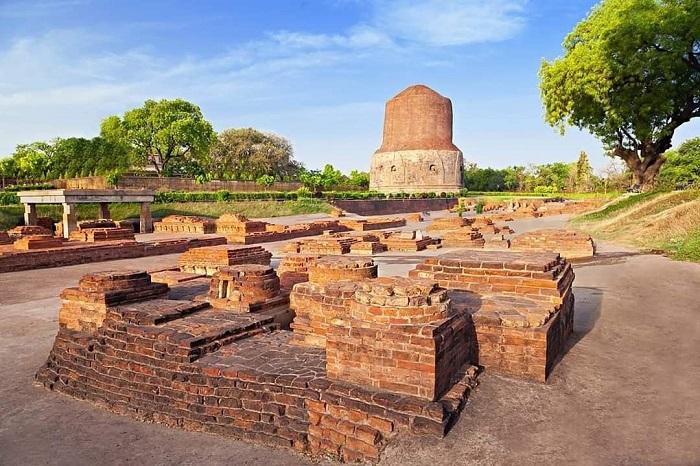
History of Sarnath Varanasi
Around the 5th century B.C., a young prince named Siddhartha Guatama was born in Lumbini. He led a very sheltered and lavish life. However, just before he turned 30, he ventured out into the countryside, where he encountered illness and death. after seeing this he gives everything up and searches for liberation from suffering. Eventually, he realized that liberation comes from disciplining the mind. He then sat down to meditate under a sacred fig tree and resolved not to get up until he became enlightened. It happened profoundly on one full moon night. The tree (Bodhi tree) was located at the site of the magnificent Mahabodhi temple in Bodhgaya.
The Buddha didn’t start preaching at Bodhgaya. There were five people he wanted to teach first. The Buddha heard they were dwelling in a deer park at Sarnath, and they became his first disciples. Here Buddha gave his first Sermon to these disciples. Sarnath derives from the Sanskrit Saranganatha, which means “Lord of the Deer”. It relates to another old Buddhist story in which the Bodhisattva is a deer and offers his life to a king. The king is so moved that he creates the park as a sanctuary for deer. The park is active in modern days. Sarnath also known as Singhpur, a village approximately 1 kilometer away from the site, was the birthplace of Shreyansanath, the Eleventh Tirthankara of Jainism.
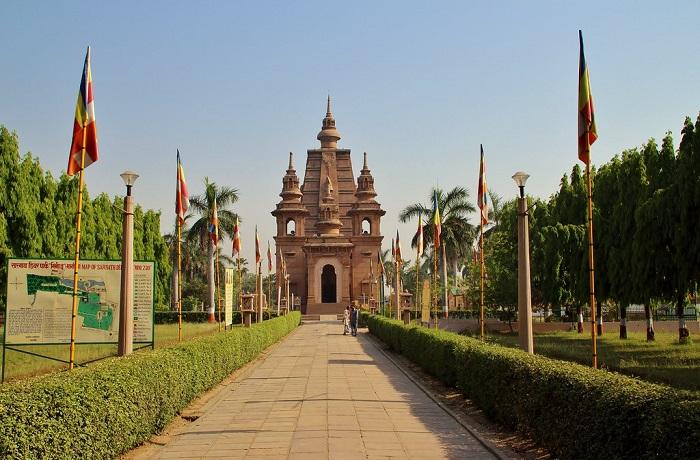
Sarnath is situated near the confluence of the Ganges and the Varuna rivers. Sarnath has been variously known as Mrigadava, Rishipattana, and Isipatana throughout its long history. Mrigadava means “deer park” and “Isipatana” means the place where holy men landed. The legend says that when the Buddha-to-be was born, some devas came down to announce it to 500 rishis.
Most of the structures at Sarnath were built by Mauryan Emperor Ashoka a couple of centuries after the religion was established. He enthusiastically went about constructing stupas and pillars across India to promote the religion. The most celebrated pillar is the one Sarnath Ashok Stambh. The national emblem of India. It features four lions and a dharma chakra (the wheel representing Buddhist teachings), which is derived from it. The chakra also appears on the Indian flag.
Places to visit in Sarnath Varanasi
The main attraction is the Dhamekh stupa complex, where the excavated Sarnath ruins are located. It’s set in a landscaped park and contains the well-preserved Dhamekh Stupa (the Spot where the Buddha is believed to have delivered his first sermon), The remains of Buddhist monasteries are also the best attraction in Sarnath. The attractive Sarnath Archaeological Museum is situated next to the Dhamekh stupa complex and consists of interesting artifacts dating from the 3rd century B.C. to the 12th century A.D. The impressive top of the Ashoka Pillar is also a highlight. The Chaukhandi Stupa is another major stupa that’s in relatively good condition. It marks the spot where the Buddha met up with his five companions. A Sound and light show takes place every evening in the park at Dhamekh stupa. It narrates Lord Buddha’s life and teachings in the enchanting baritone voice of popular Bollywood actor Amitabh Bachchan.
Also, read- The Incredible reason to Visit Chikhaldara Hill Station Maharashtra
Dhamekh Stupa
This is the exact spot or Rishipattana where Lord Buddha revealed his first eightfold path sermon to disciples, Dhamek Stupa is the main stupa of Sarnath. King Ashoka had passed the orders to renovate the existing Buddhism tumuli in the 3rd century BC which was completed 2,500 years ago. The cylindrical stupa is made entirely out of bricks with a formidable diameter of 28 meters. Elaborate murals, wall carvings, and a small museum after the entrance provide deep insights into the monument’s and Buddha’s teachings. The beautiful Dhamek Stupa attracts devotees and Buddhist pilgrims, from all around the world.

Ashoka Pillar
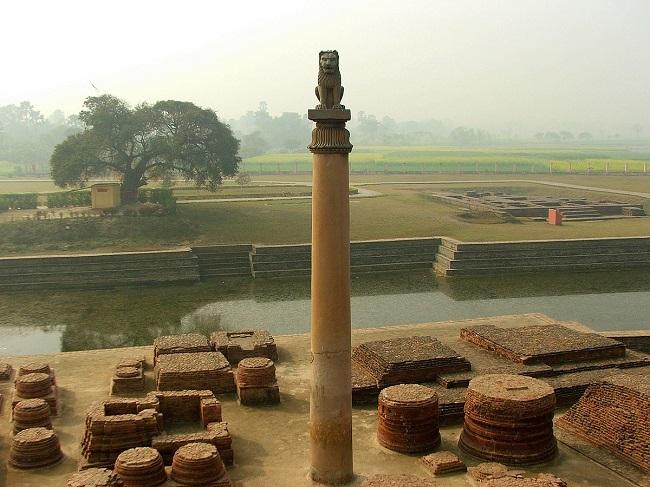
Thai Temple and Monestry
This magnificent temple was erected by Thai dignitaries who visited Sarnath in the year 1993. Adorned with manicured gardens, the temple is one of the most beautiful places to visit in Sarnath. The temple complex also includes an old tree which is muffled up with a striking shawl of gold leaf. Buddhist pilgrimage sites are famous for the 24-meter image of Buddha in a standing position. Besides this statue, the temple also houses 3 other effigies of Lord Buddha in various postures that are placed beneath a tree.
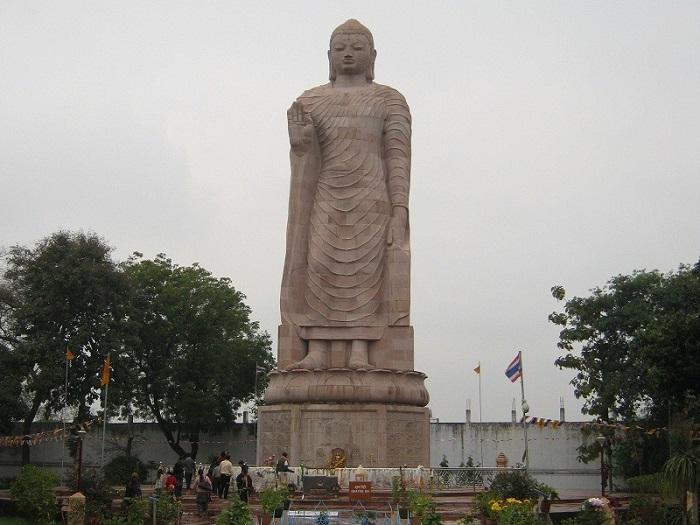
Shri Digambar Jain Temple, Singhpuri
Sarnath is the birthplace of the 11th Tirthankara Shri Shreyansanatha Bhagwan. It is the place where 4 of the 5 Kalyanak (auspicious life events) of Shri Shreyansanatha Bhagwan took place. A huge ashtakod stoop (octagonal pillar), 31.4 meters in height is still present showing its historical establishment. It is considered to be 2200 years old. The main deity of this temple is a blue-colored idol of Shri Shreyansnath Bhagwan, 75 centimeters in height, in Padmasana.

Chaukhandi Stupa
The Chaukhandi Stupa is known as one of the most divine and important monuments of Buddhist culture. This stupa has been built on the exact spot where the great Lord Buddha first met his five disciples- to whom he later went on to preach his first teachings. The monument has been erected as a commemoration of this significant event that eventually played important role in the rise of the Buddhism religion. The Chaukhandi Stupa is an evolution over burial mounds and serves as a shrine to the great Lord Buddha.
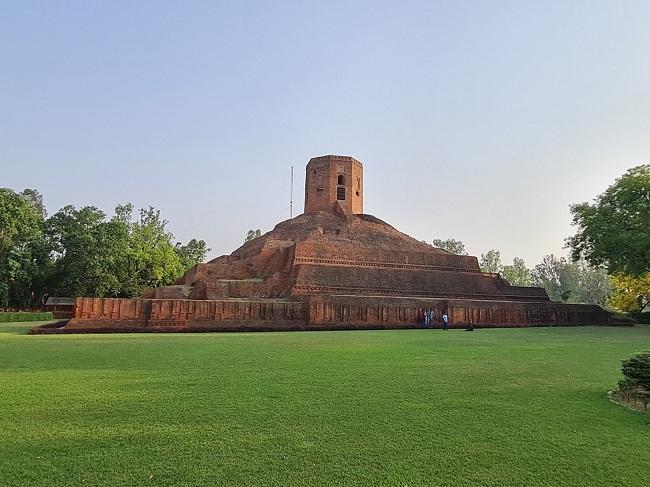
How to Visit SarnathVaranasi
Sarnath is located about 10 kilometers from Varanasi, making it an easy half-day trip from Varanasi. Varanasi is well connected to all major cities of India as well as abroad. There are various ways of getting Sarnath from Varanasi. The most convenient way is to take a cab. Cheaper buses and shared auto rickshaws are also available from Varanasi Junction railway station.
Sources-Livehistoryindia.com, varanasi.org, wikipedia.org,tripsavvy.com
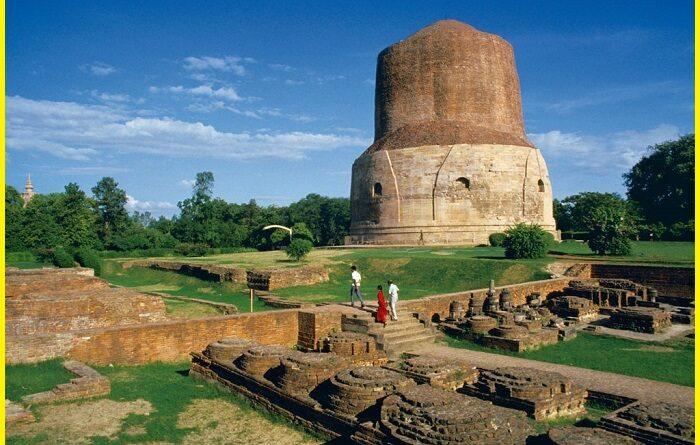
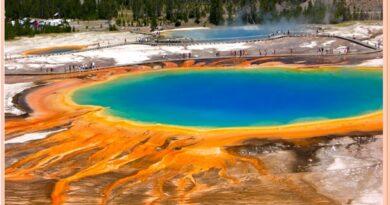


Pingback: Kashi Vishwanath Temple and Varanasi-A Holy City in India - Geotourism